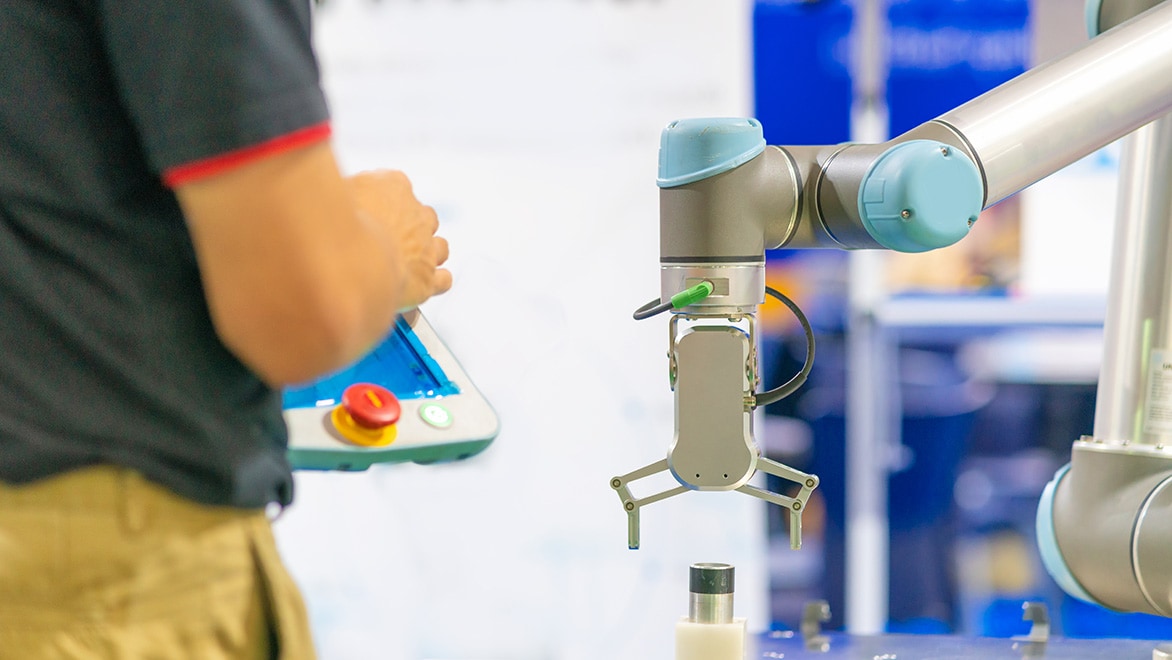& Construction

Integrated BIM tools, including Revit, AutoCAD, and Civil 3D
& Manufacturing

Professional CAD/CAM tools built on Inventor and AutoCAD
A cobot is a robotic system designed to work directly with or close to a human, harnessing the skills and advantages of both and ensuring worker safety through advanced sensor and materials technology.
Traditional industrial robots are caged or walled off because their rapid repetitive motions and heavy materials often pose a danger to operators and coworkers. By contrast, cobots in manufacturing add efficiencies and value by working directly or sharing the workspace with human coworkers.
Cobots and people working together save space and reduce some of the cumbersome and expensive safety measures of traditional manufacturing. Integrating cobots into the workplace lets you design processes that combine the unique skills and abilities of human workers and robots to work faster and better.
Some industrial cobotics merely share the workspace with a human without any direct overlap; some work in sequence with the actions of a human; and some react to a human operator’s work, responsively matching pace and output in real time.
Consequently, cobots are ushering in a new style of manufacturing that brings out the best in robots and humans.
Cobots have a modular nature and a footprint that’s usually smaller than that of industrial robots, offering compelling benefits for manufacturing.
Industrial robots can take weeks to install, program, and test, but with a far nimbler profile, a cobot can be set up to run within hours.
Cobots from today’s third-party providers come with easy-to-use cobot software. Many of these cobots are controllable from a mobile device, letting users outline and save actions easily.
Because of the speed of setup, cobots in manufacturing can be easily redeployed in other areas to perform different tasks in the production line or operating process.
Humans aren’t built for identical repetitive motions, which makes cobots the ideal partner for taking over high-precision, repetitive mechanical actions in a larger operation.
By far, the biggest advantages of human-robot collaboration are a rise in output, an increased production rate, and improved product quality.
A primer on the new paradigms of robots in manufacturing, with industrial cobotics as a critical component of the factory of tomorrow.
Watch our webinar on the place cobots will soon have in the construction industry.
In a class from Autodesk University, learn about the toolset enabling and enhancing collaboration between human and robot workers.
Traditional industrial robots work alone in clearly established workspaces, often with a physical barrier safely separating the robot from the human team, performing strictly timed and programmed actions.
A cobot is a collaborative robot that works closely alongside or in a direct partnership with a human operator, whose safety is assured through sensor and materials technology.
So far, cobots have found a home in factory, site, and plant settings in manufacturing and construction where frequent, precise, and repetitive actions can augment tasks performed by human workers.
Industrial cobotics are designed to occupy the same physical space as human workers. Cobots can carry out their part in the process without direct human interaction, or they can use sensory data to respond to human actions.
Cobots programmed to respond to the actions of a human coworker are tailor-made for AI. Where industrial robots follow programs for fixed behaviors like operating rate and sequence of movement, cobots work very differently. The more experience a cobot has working with humans, the more data it has available to adjust its behavior using machine learning.

